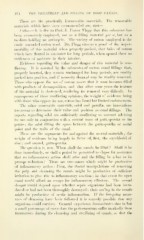Page 466 - My FlipBook
P. 466
—
464 THE TREATMENT AND FILLING OF ROOT CANALS.
These are the practically irremovable materials. The removable
materials whieli hav(> been recommciKled ar(>, first
Cotton.— It is (hie to Proi'. J. Foster Flat^tr tiiat this substam-e has
been extensively emj)l()ye(l, not as a filling material per xc, but as a
medium holding an antiseptic. The variety of cotton employed is the
crude unearded cotton wool. Dr. Flagg- cites as a proof of the imper-
meability of this material when properly packed, that bales of cotton
which have floated in sea-water for long periods, when opened show no
evidences of moisture in their interior.
Evidence regarding the value and danger of this material is con-
flicting. It is asserted by the advocates of cotton canal fillings that,
properly inserted, they remain unchanged for long periods, are readily-
packed into position, and if necessity demand may be readily removed..
Those who oppose the use of cotton assert that it soon becomes filled
with products of decomposition, and that after some years the texture
of the material is destroyed, rendering its removal very difficult. In
consequence of these conflicting opinions, the weight of evidence being
w'ith those who oppose its use, cotton has found but limited endorsement.
The other removable materials, salol and paraffin, are innovations
too recent to determine their value and position as canal fillings. The
reports regarding salol are sufficiently conflicting to warrant advising
its use only in conjunction with a central mass of gutta-percha or tin
points ; the salol filling the space between the gutta-percha or metal
point and the walls of the canal.
These ai'e the arguments for and against the several materials ; the
weight of evidence being largely in favor of, first, the oxychlorid of
zinc ; and second, gutta-percha.
The question is, now. When shall the canals be filled ? Shall it be
done immediately, or shall a period be permitted to elapse for assurance
that no inflammatory action shall arise and the filling be a bar to its
prompt reduction ? There are two causes which might be productive
of inflammatory action : First, the dental manipulations of removing
the pulp and cleansing the canals might be productive of sufficient
irritation to give rise to inflammatory reaction ; in that event the open
canal would afford an escape for inflammatory effusions. The second
danger would depend upon wdiether septic organisms had been intro-
duced or had not been thoroughly destroyed ; their sealing in the canals
might be productive of septic inflammation. If the foregoing meas-
ures of cleansing have been followed it is scarcely possible that any
organisms could survive. General experience demonstrates that in but
a small percentage of cases does the pericementum suffer markedly from
traumatism during the cleansing and sterilizing of canals, so that the
464 THE TREATMENT AND FILLING OF ROOT CANALS.
These are the practically irremovable materials. The removable
materials whieli hav(> been recommciKled ar(>, first
Cotton.— It is (hie to Proi'. J. Foster Flat^tr tiiat this substam-e has
been extensively emj)l()ye(l, not as a filling material per xc, but as a
medium holding an antiseptic. The variety of cotton employed is the
crude unearded cotton wool. Dr. Flagg- cites as a proof of the imper-
meability of this material when properly packed, that bales of cotton
which have floated in sea-water for long periods, when opened show no
evidences of moisture in their interior.
Evidence regarding the value and danger of this material is con-
flicting. It is asserted by the advocates of cotton canal fillings that,
properly inserted, they remain unchanged for long periods, are readily-
packed into position, and if necessity demand may be readily removed..
Those who oppose the use of cotton assert that it soon becomes filled
with products of decomposition, and that after some years the texture
of the material is destroyed, rendering its removal very difficult. In
consequence of these conflicting opinions, the weight of evidence being
w'ith those who oppose its use, cotton has found but limited endorsement.
The other removable materials, salol and paraffin, are innovations
too recent to determine their value and position as canal fillings. The
reports regarding salol are sufficiently conflicting to warrant advising
its use only in conjunction with a central mass of gutta-percha or tin
points ; the salol filling the space between the gutta-percha or metal
point and the walls of the canal.
These ai'e the arguments for and against the several materials ; the
weight of evidence being largely in favor of, first, the oxychlorid of
zinc ; and second, gutta-percha.
The question is, now. When shall the canals be filled ? Shall it be
done immediately, or shall a period be permitted to elapse for assurance
that no inflammatory action shall arise and the filling be a bar to its
prompt reduction ? There are two causes which might be productive
of inflammatory action : First, the dental manipulations of removing
the pulp and cleansing the canals might be productive of sufficient
irritation to give rise to inflammatory reaction ; in that event the open
canal would afford an escape for inflammatory effusions. The second
danger would depend upon wdiether septic organisms had been intro-
duced or had not been thoroughly destroyed ; their sealing in the canals
might be productive of septic inflammation. If the foregoing meas-
ures of cleansing have been followed it is scarcely possible that any
organisms could survive. General experience demonstrates that in but
a small percentage of cases does the pericementum suffer markedly from
traumatism during the cleansing and sterilizing of canals, so that the


